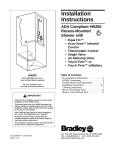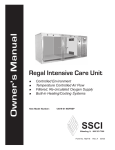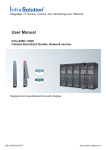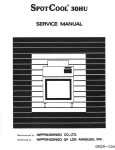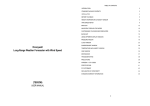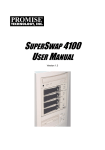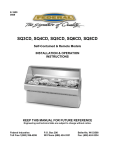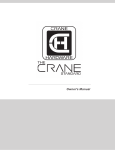Download Suburban Mfg 12155-00-DRDRAA User's Manual
Transcript
Owner’s Manual Oxygen Therapy Door Converts standard Regal cage into an oxygen therapy chamber Models to fit most single-door Regal cages Door-mounted thermometer/hygrometer Outside compartment for nebulizer and ice New Model Numbers: 12155-00-DRDRAA, 12155-00-DREPAA, 12155-00-EPDRAA, 12155-00-EPEPAA, 12155-00-EPFNAA, 12155-00-EPHJAA, 12155-00-FNFNAA, 12155-00-FNHJAA Former Model Numbers: 102563-1, 102566-1, 102564-1, 102567-1, 102568-1, 102570-1, 102573-1, 102575-1 SSCI Wheeling, IL (800) 323 7366 Form No. 702703 Rev. E 08/06 Warning: Oxygen is a highly combustible gas. Avoid the use of open flames, smoking materials, or equipment capable of producing sparks in any area in which oxygen is being used. © Copyright 2006 by Suburban Surgical Co., Inc. All rights reserved. No part of this document may be reproduced or utilized in any form or by any means, electronic or mechanical, including photocopying, recording, or by any information storage and retrieval system without written permission. Inquiries should be addressed to Suburban Surgical Co., Inc. Wheeling, Illinois 60090, USA Owner’s Manual - Oxygen Therapy Door Table of Contents Chapter 1 - General Information ................................................................. 1 Introduction ................................................................................................................................ 1 About this Manual ...................................................................................................................... 1 Information and Safety Notices ................................................................................................... 2 Notes ............................................................................................................................. 2 WARNINGS ................................................................................................................. 2 Models ....................................................................................................................................... 2 Care and Cleaning of Stainless Steel ............................................................................................ 3 Introduction .................................................................................................................... 3 Cleaning and Cleansers ................................................................................................... 3 Deodorizing Agents, Disinfectants and Sanitizers .............................................................. 4 Effect on Warranty .......................................................................................................... 4 Safety ......................................................................................................................................... 4 Cleaning Requirements ................................................................................................................ 4 SSCI Contact Information .......................................................................................................... 5 Warranty .................................................................................................................................... 5 Chapter 2 - Installation and Setup............................................................... 7 Unpacking and Inspection ........................................................................................................... 7 Parts Included ............................................................................................................................ 7 Installation and Setup .................................................................................................................. 7 Tools Required ............................................................................................................... 7 Procedure ...................................................................................................................... 8 Disposition of the Shipping Carton .............................................................................................. 9 Chapter 3 - Operating and Cleaning ......................................................... 11 Door and Latch ........................................................................................................................ 11 Door Seals ................................................................................................................... 11 Opening and Closing ..................................................................................................... 11 Latch Adjustment .......................................................................................................... 11 Ice Tray .................................................................................................................................... 12 Gauges ..................................................................................................................................... 12 General ........................................................................................................................ 12 Cautions ....................................................................................................................... 12 Maximum/Minimum Temperature and Humidity Recording ............................................. 13 Changing Between °C and °F Displays .......................................................................... 13 Replacing the Gauge Battery ......................................................................................... 13 Using the Nebulizer ................................................................................................................... 14 Oxygen Concentration Control .................................................................................................. 15 Form No. 702703 Rev. E August, 2006 i Table of Contents Cleaning Instructions ................................................................................................................. 16 Introduction .................................................................................................................. 16 Stainless Steel Cleaning Procedures .............................................................................. 16 Clear Polycarbonate Cleaning Procedures ..................................................................... 16 Ice Tray Cleaning Procedures ....................................................................................... 16 Nebulizer Cleaning Procedures ..................................................................................... 16 Chapter 4 - Repairs and Replacements .................................................... 17 Replacement Parts .................................................................................................................... 17 General Information .................................................................................................................. 18 Parts Ordering Procedure ......................................................................................................... 18 Procedures ............................................................................................................................... 19 Nebulizer Assembly, Complete ...................................................................................... 19 Tool Required ............................................................................................. 19 Procedure .................................................................................................. 19 Nebulizer Assembly, Partial ........................................................................................... 20 Nebulizer Oxygen Supply Hose .................................................................................... 20 Nebulizer Hose Barb Fitting .......................................................................................... 21 Tools Required ........................................................................................... 21 Procedure .................................................................................................. 21 Nebulizer Extension ...................................................................................................... 22 Nebulizer Cotter Pin ..................................................................................................... 22 Gauge Assembly ........................................................................................................... 22 Overview ................................................................................................... 22 Tools Required ........................................................................................... 22 Removal - Old-style Gauge ......................................................................... 22 Removal - New-style Gauge ....................................................................... 23 Installation of New-style Gauge ................................................................... 23 Ice Tray ........................................................................................................................ 25 Ice Tray Valve .............................................................................................................. 25 Tools Required ........................................................................................... 25 Procedure .................................................................................................. 25 Seal Strip Retainer and Seal Strip .................................................................................. 26 Parts Identification ...................................................................................... 26 Tools Required ........................................................................................... 26 Procedure .................................................................................................. 26 Chapter 5 - Troubleshooting ..................................................................... 29 General .................................................................................................................................... 29 Returning the Oxygen Therapy Door for Repairs ....................................................................... 30 RMA Numbers ............................................................................................................. 30 Packing and Shipment ................................................................................................... 30 There is no oxygen flow into the cage. ....................................................................................... 31 There is excessive oxygen leakage from the cage. ...................................................................... 32 The door does not close or latch correctly. ................................................................................ 33 One or both of the gauges does not read correctly. .................................................................... 34 ii SSCI - Suburban Surgical Company, Inc. Owner’s Manual - Oxygen Therapy Door Chapter 1 - General Information Introduction The SSCI Oxygen Therapy Door transforms your standard Regal cage into an oxygen therapy chamber. The clear door features a continuous-flow nebulizer with .25 in (.635 cm) inner diameter x .062 in (.16 cm) thick tubing to deliver a regulated flow of medicated, moist oxygen. A thermometer/hygrometer mounted on the door monitors cage temperature and humidity for optimal treatment. The clear polycarbonate door allows you to view the animal at all times. A detachable compartment on the outside holds the oxygen nebulizer and ice to cool the oxygen if needed. The door mounts onto the front of the cage in place of the regular door, and uses standard hinges and latches to close securely. Rubber door seals on all four sides of the door are open at the corners to uniformly distribute oxygen and exhaust carbon dioxide. About this Manual Form No. 702703 Rev. E Every attempt has been made to insure that the information in this manual is correct and complete. SSCI, however, always welcomes our customer’s suggestions for improvements to our products and associated publications. August, 2006 1 Chapter 1 - General Information Information and Safety Notices Throughout this manual you will find text under the headings Note: and WARNING:. Notes Under the Note: headings, you will be given additional information pertinent to the subject discussed in that paragraph or step. Example: Push the oxygen supply hose onto the new fitting. Note: A small amount of grease on the barbs will ease assembly. WARNINGS Under the WARNING: headings, you will be alerted to potentially hazardous conditions which, if ignored or mishandled, could result in injury to yourself, or damage to the equipment. Example: WARNING: Oxygen is a highly combustible gas. Avoid the use of open flames, smoking materials, or equipment capable of producing sparks in any area in which oxygen is being used. Models The SSCI Oxygen Therapy Door is available in eight different models, based on Regal cage sizes. Note: Dimensions shown in Table 1 are cage sizes. New P/N Former P/N Dimensions (in.) Dimensions (cm) 12155- 00- DRDRAA 10 2 5 6 3 - 1 24W x 24H 60.96W x 60.96H 12155- 00- DREPAA 102566- 1 24W x 30H 76.20W x 60.96H 12155- 00- EPDRAA 102564- 1 30W x 24H 60.96W x 76.20H 12155- 00- EPEPAA 102567- 1 30W x 30H 76.20W x 76.20H 12155- 00- EPFNAA 102568- 1 36W x 30H 9 1. 4 4 W x 7 6 . 2 0 H 12155- 00- EPHJAA 102570- 1 48W x 30H 12 1. 9 2 W x 7 6 . 2 0 H 12155- 00- FNFNAA 102573- 1 36W x 36H 91.44W x 91.44H 12155- 00- FNHJAA 102575- 1 48W x 36H 121.92W x 91.44H Table 1. Models - Oxygen Therapy Door 2 SSCI - Suburban Surgical Company, Inc. Owner’s Manual - Oxygen Therapy Door Care and Cleaning of Stainless Steel Introduction Stainless steel is steel alloyed with chromium to make it highly resistant to stain, rust and corrosion. Note: This does NOT mean that stainless steel will never rust or corrode. Science has not yet developed a steel which is completely stainless or corrosion PROOF. The type of stainless steel and finish selected by SSCI for the Oxygen Therapy Door is the best available for the intended use. Cleaning and Cleansers The basic rule of thumb is to use the mildest cleaning procedure that will do the job effectively. Always rinse thoroughly with clear water, and dry completely. Frequent cleaning will prolong the service life of stainless steel equipment and will help maintain a bright, pleasing appearance. Ordinary deposits of waste and fluids can usually be removed with soap and water. More stubborn deposits or tightly adhering debris may require harder scrubbing and possibly the use of commercial cleaning products acceptable for use on metal surfaces. When using any cleaning agent, rub in the direction of the polish lines or “grain” of the metal. For high luster finishes, clean soft cloths or pads should be used. If especially rough cleaning is necessary, use “stainless steel” wool, nylon or plastic scrubbers. Test these scrubbers in an inconspicuous area first to be sure they do not mar or scratch the stainless steel finish. Minor scale build-up and some hard water spotting may be removed by washing with vinegar, followed by a neutralizing rinse with clear water and a thorough drying with a soft cloth. For heavy deposits of scale, 5% oxalic acid (use warm), 5-15% sulfamic acid, or 5-10% phosphoric acid may be used. Always follow with a neutralizing rinse of clean water and a thorough drying. Form No. 702703 Rev. E August, 2006 3 Chapter 1 - General Information Deodorizing Agents, Disinfectants and Sanitizers The large selection of brands and combinations of chemicals available for deodorizing, disinfecting and sanitizing is staggering. Select one or more agents for use in your facility only after weighing all the benefits claimed by each product. Often this choice is made without adequate consideration of the effects these agents may produce on equipment or furnishings. CAUTION: Before selecting a chemical to employ in your facility, review label statements regarding use with metals (stainless steel). Always consult the chemical supplier if there are any doubts. Avoid prolonged use of chlorides (such as chlorine bleach), bromides, iodides and thiocyanates on stainless steel surfaces as these chemicals will cause pitting, corrosion and metal discoloration. Allowing salty solutions to evaporate and dry on stainless steel may also contribute to corrosive conditions. In summary, select chemical deodorizers, disinfectants and/or sanitizers only after weighing all possible benefits and known adverse effects. Effect on Warranty The warranty for this product is void if the care and cleaning instructions provided in this manual are not followed. Safety WARNING: Oxygen is a highly combustible gas. Avoid the use of open flames, smoking materials, or equipment capable of producing sparks in any area in which oxygen is being used. Cleaning Requirements Clean the Oxygen Therapy Door exactly in accordance with the cleaning instructions provided in Chapter 3 of this manual. Failure to follow these instructions can void your warranty. 4 SSCI - Suburban Surgical Company, Inc. Owner’s Manual - Oxygen Therapy Door SSCI Contact Information Contact SSCI Customer Service by mail, telephone or fax. The department is available from 8:30am to 5:00pm, Central Time, Monday through Friday. Closed holidays. Address: Suburban Surgical Co., Inc. 275 Twelfth Street Wheeling, Illinois 60090 Telephone: Illinois - (847) 537-9320, ext. 3518 Toll Free - (800) 323-7366 Warranty Fax: (847) 537-9061 Web: www.suburbansurgical.com Suburban Surgical Company, Inc. warrants the original purchaser that our products are of the highest standards in material and workmanship. Our stainless steel components are guaranteed to last a lifetime assuming they are used as intended, properly maintained and cared for. Mechanical, electrical, electronic, hydraulic, and any product’s devices carry a one year warranty. Items purchased by Suburban Surgical Company, Inc. from other manufacturers and incorporated into our equipment are covered by the respective manufacturer’s warranties. Warranties will not apply if it is determined by Suburban Surgical Company, Inc. that the equipment became defective due to an accident, misuse, abuse, improper maintenance or alteration. Warranty freight charges are covered for the first year only. Form No. 702703 Rev. E August, 2006 5 Chapter 1 - General Information Comments: 6 SSCI - Suburban Surgical Company, Inc. Owner’s Manual - Oxygen Therapy Door Chapter 2 - Installation and Setup Unpacking and Inspection If the shipping container appears damaged in any way, contact the shipping company immediately. Save all damaged packing materials to assist in proving liability for damage. Carefully inspect your Oxygen Therapy Door while you unpack it. If damage is noted, or if parts appear to be missing, call SSCI Customer Service at (800) 323-7366. Parts Included The following parts are included in the shipment (Figure 1): Oxygen Therapy Door Ice tray with valve Nebulizer with supply tubing Nebulizer With Supply Tubing Oxygen Therapy Door Ice Tray With Valve Figure 1. Parts Included in Shipment Installation and Setup Tools Required Form No. 702703 Rev. E August, 2006 Phillips screwdriver Punch (1/4 in. dia. max.) Small hammer or mallet 7 Chapter 2 - Installation and Setup Procedure 1. With a 1/4 in. or smaller punch and a small hammer, remove both hinge pins from the cage door (Figures 2 and 3). 2. Remove the door from the cage. Hinge Pin (shown partially out) Hinges Hinge Figure 2. Hinges on a Regal Cage Figure 3. Door Hinge and Hinge Pin 3. Open the door and, on the rear of the gauge, pull the tape marked “REMOVE TO START” from the battery compartment. The gauge will begin operating. 4. Hang the oxygen therapy door on the existing cage hinges and install the original hinge pins (Figure 4). 5. Hang the ice tray on the button hooks provided on the door (Figures 4 and 5). Opening for Nebulizer Extension Ice Tray Button Hooks Figure 4. Oxygen Therapy Door in Place on a Regal Cage 8 Ice Tray Figure 5. Ice Tray in Place SSCI - Suburban Surgical Company, Inc. Owner’s Manual - Oxygen Therapy Door Extension Cotter Pin Figure 7. Nebulizer in Place Figure 6. Nebulizer 6. On the nebulizer extension, squeeze the two ends of the cotter pin together and remove the pin from the extension (Figure 6). 7. Open the oxygen therapy door. 8. Place the nebulizer in the ice tray with the extension through the opening in the door (Figures 5, 6, and 7). 9. Inside the door, replace the cotter pin through the extension to hold the nebulizer in place and spread the two cotter pin ends apart to keep the pin from falling out. 10. Attach the free end of the nebulizer plastic tubing to a 50 psi wall oxygen outlet or an oxygen cylinder. Note: Your oxygen supplier is the best source to make this connection for you. Installation and setup is complete. Your SSCI Oxygen Therapy Door is now ready for use. Disposition of the Shipping Carton Form No. 702703 Rev. E The shipping carton can be cut up and thrown away. If adequate space is available, however, it might be handy to retain the carton in case reshipment of the door to the manufacturer ever becomes necessary for repairs. August, 2006 9 Chapter 2 - Installation and Setup Comments: 10 SSCI - Suburban Surgical Company, Inc. Owner’s Manual - Oxygen Therapy Door Chapter 3 - Operating and Cleaning Warning: Oxygen is a highly combustible gas. Avoid the use of open flames, smoking materials, or equipment capable of producing sparks in any area in which oxygen is being used. Door and Latch Door Seals The door has flexible rubber seal strips (Figure 8) on all four sides to prevent the escape of oxygen. The corners are open to help distribute the oxygen uniformly, and allow for the escape of carbon dioxide. Open Space Seal Strip Bracket Bracket Screw Latch Connector Seal Strip Figure 8. Door Seals and Open Space Opening and Closing Similar Bracket & Screw Figure 9. Door Latch and Adjustments The door is held closed by a self-actuating latch connector (Figure 9). As the door is closed, the latch connector rides up and over the handle and then falls down, locking the door closed. To open the door, lift up on the latch connector and pull the door open. Latch Adjustment If the latch connector and door are not properly adjusted, you may have difficulty in opening the door, and it may not lock automatically when closed. To adjust the door, loosen the bracket screws (Figure 9), move the brackets slightly up or down as needed, then retighten the screws. Try the door again, and repeat the adjustment until the latch connector and latch work together smoothly. If the above adjustment is not adequate, you may have to loosen the screws on the door hinge brackets and move the entire door up or down slightly. Form No. 702703 Rev. E August, 2006 11 Chapter 3 - Operating and Cleaning Ice Tray The ice tray can be used for ice baths, warm water, warm chemical packs - whatever your current treatment requires. The tray cannot be easily removed from the door if the nebulizer is in place. Therefore, a valve is provided on the bottom of the tray to facilitate the disposal of used water (Figure 10). The valve handle positions are: Horizontal Closed - No flow Vertical Open - Flow You can attach a piece of .375 in. ID tubing to the barbed tubing connection on the valve to drain the tray to a remote location. Handle: Horizontal - No Flow Vertical Flow (Flow position shown) Barbed Tubing Connection Figure 10. Ice Tray Valve Figure 11. Temperature/Himidity Gauge Gauges General A two-function, digital gauge is located on the upper left of the oxygen therapy door (Figure 11). This battery-powered gauge includes a thermometer and a hygrometer to allow you to monitor cage temperature and humidity for optimal treatment conditions. In addition to displaying current conditions, the gauge features Max/ Min readouts with memory, and the ability to display temperature in degrees Centigrade or Fahrenheit. Temperature Range: 32 -122°F (0 - 50° C) Temperature Resolution: 1°F Humidity Range: 20 - 99% Humidity Resolution: 1% Cautions 12 Do not attempt to take the gauge apart. Use only the recommended battery type. No not expose the gauge to liquid water. Dispose of old batteries only in accordance with local regulations. SSCI - Suburban Surgical Company, Inc. Owner’s Manual - Oxygen Therapy Door Maximum/Minimum Temperature and Humidity Recording As the gauge operates, it records the maximum and minimum temperatures and humidities reached since the last time the Clear Button was pressed. Use a small, pointed instrument, or an unbent paper clip, to press the Max /Min Button (Figure 12) on the gauge. Press once to read the maximum, and once again to read the minimum. Press the button a third time to return to the current reading. The gauge shows MAX or MIN when either of these values is displayed. Press the Clear Button (Figure 12) to delete the previous maximum and minimum readings and begin recording anew. Front View of Gauge Max/Min Button Clear Button °C / °F Slide Switch Rear View of Gauge Figure 13. Changing Between °C and °F Figure 12. Gauge Buttons Changing Between °C and °F Displays A slide switch on the side of the gauge (Figure 13) allows you to select between °Centigrade and °Fahrenheit temperature readings. Slide the switch UP to select °Centigrade; and DOWN to select ° Fahrenheit. Replacing the Gauge Battery The gauge is powered by a 3.0 volt, lithium, Type CR2032 battery which you can obtain locally. The battery is contained in a built-in slide in the top of the gauge (Figure 14). Just pull the battery slide up with your finger to open, and remove the battery. When replacing the battery, notice that the battery is marked with a “+” sign on one side, and the battery slide is marked with two “+” signs (Figure 15). All “+” signs must be on the same side and must face the front of the gauge. With the battery in the slide, press the slide downward until it clicks into place. Form No. 702703 Rev. E August, 2006 13 Chapter 3 - Operating and Cleaning Battery Slide Battery + + + Battery Slide Battery Rear View of Gauge Figure 15. Battery Slide and Battery Removed from Gauge Figure 14. Gauge Battery Slide and Battery Using the Nebulizer We at SSCI are not licensed veterinarians. Please use your experience, and refer to professional literature for advice on proper dosages and usage of medications, and appropriate concentrations of oxygen. Note: The nebulizer is designed for single patient use only. Follow the steps below to use the nebulizer: 1. Unscrew the bottle from the cap. 2. Fill the bottle to the “Maximum” line with sterile water (Figure 16). 3. Screw the bottle back into the cap. “Maximum” Line Cap Bottle Figure 16. Nebulizer Cap and Bottle 14 SSCI - Suburban Surgical Company, Inc. Owner’s Manual - Oxygen Therapy Door Oxygen Concentration Control 4. Set the oxygen flow to 10 liters per minute or higher if more flow is needed. 5. Refer to Oxygen Concentration Control on below to set the desired oxygen concentration. A simple regulator collar on the nebulizer allows you to control the oxygen percentage concentration in the cage from 28% to 98%. Simply rotate the regulator collar on the nebulizer to the approximate desired percentage (Figure 17). An arrow head molded on the side of the nebulizer neck indicates the selected percentage concentration. Vent Regulator Collar Arrow Head Figure 17. Oxygen Concentration Control As you rotate the regulator collar, the size of the vent opening increases or decreases. The vent opening is larger at low oxygen concentrations to allow a greater amount of ambient air to enter. Form No. 702703 Rev. E August, 2006 15 Chapter 3 - Operating and Cleaning Cleaning Instructions Introduction You will no doubt want to clean your oxygen door and cages whenever they become dirty or saturated with waste fluids. Maintaining high standards of sanitation will be an important priority for your facility. Stainless Steel Cleaning Procedures Ordinary deposits of waste and fluids can usually be removed with soap and water. Stubborn deposits may require scrubbing with “stainless steel” wool, nylon or plastic scrubbers and/or the use of commercial cleaning products. Always scrub in the direction of the “grain” of the metal. Rinse with clear water and dry thoroughly with a clean, soft cloth. Minor scale build-up and some hard water spotting may be removed by washing with vinegar, followed by a neutralizing rinse of clear water and a thorough drying with clean, soft cloths. For heavy deposits of scale, 5% oxalic acid (use warm), 5-15% sulfamic acid, or 5-10% phosphoric acid may be used. As always, rinse with clear water and dry thoroughly with clean soft cloths. Avoid prolonged use of chlorides (such as chlorine bleach), bromides, iodides and thiocyanates. Never allow salty solutions to dry on the stainless steel. Note: NEVER power-wash the oxygen therapy door. Clear Polycarbonate Cleaning Procedures Ice Tray Cleaning Procedures Nebulizer Cleaning Procedures 16 Rinse the polycarbonate window with clear water and dry thoroughly with a clean, soft cloth. The ice tray should be removed and washed periodically - at least weekly. With heavy use, more frequent washing may be necessary. Wash the tray in hot, soapy water, rinse with hot clear water, then dry thoroughly with a clean, soft cloth. Open the valve and make sure it is completely cleaned and flushed. Open and close the valve several times to make sure it operates freely. The nebulizer and bottle should be removed and washed periodically - at least weekly. With heavy use, more frequent washing may be necessary. Wash both items in hot, soapy water, rinse with hot clear water, then dry thoroughly with a clean, soft cloth. Rotate the regulator collar back and forth to make sure it operates freely. SSCI - Suburban Surgical Company, Inc. Owner’s Manual - Oxygen Therapy Door Chapter 4 - Repairs and Replacements Warning: Oxygen is a highly combustible gas. Avoid the use of open flames, smoking materials, or equipment capable of producing sparks in any area in which oxygen is being used. Before servicing or performing maintenance on the oxygen therapy door, make sure the oxygen supply is turned off at the source. Replacement Parts Table 2 lists the replacement parts available for the Oxygen Therapy Door. For parts not listed below, contact SSCI Customer Service at (800) 323-7366. Refer to Parts Ordering Procedure on Page 18. Part Name SSCI Part Number For Information, Refer to: Nebulizer Assembly, Complete 212126 Page 19 Nebulizer Assembly, Partial 749510 Page 20 Nebulizer Oxygen Supply Hose 750492 Page 20 Nebulizer Hose Barb Fitting 854546 Page 21 Nebulizer Extension 754061 Page 22 Nebulizer Cotter Pin 853071 Page 22 Gauge Assembly* 854771* Page 22 Ice Tray 202975 Page 24 Ice Tray Valve 854545 Page 24 Seal Strip Retainer (Refer to Table 3, Page 27) 605365 (24 in.) 605367 (30 in.) 605009 (36 in.) 605363 (48 in.) Page 25 Seal Strip (Refer to Table 4, Page 28) 750910 (24 in.) 750832 (30 in.) 750831 (36 in.) 750909 (48 in.) Page 25 * If replacing an old-style Gauge Assembly, also order Gauge Bracket, P/N 600162-2 (refer to Page 23). Table 2. Replacement Parts Available for the Oxygen Therapy Door Form No. 702703 Rev. E August, 2006 17 Chapter 4 - Repairs and Replacements General Information Parts Ordering Procedure 18 Many of the threaded fasteners used on SSCI products are secured with thread adhesive to insure structural integrity. Removing any screw or bolt may be difficult at first. During disassembly, retain all hardware items such as screws, nuts, lockwashers, etc. for reassembly. If you have problems with any procedure, please feel to call SSCI Customer Support at (800) 323-7366. Order new equipment, accessories and/or replacement parts from your local dealer, or directly through SSCI Customer Service. You can order by mail, telephone or fax. Refer to Contact Information on Page 5 for address, telephone and fax numbers. When ordering, please provide the following information: Your name Company name Company account number Telephone number Fax number e-mail address Shipping address Billing address (if different from shipping address) Names, part numbers, and quantities of items being ordered Credit card number and expiration date, or other payment information Preferred method of shipment Information on whether the items are required on a normal or urgent basis SSCI - Suburban Surgical Company, Inc. Owner’s Manual - Oxygen Therapy Door Procedures Nebulizer Assembly, Complete P/N 212126 This is the complete nebulizer assembly including the bottle, cap, regulator, extension, cotter pin, hose barb fitting and oxygen supply hose (Figure 18). Tool Required Needle-nose pliers Hose Barb Fitting Extension Regulator Cap Oxygen Supply Hose Cotter Pin Bottle Figure 18. Nebulizer Assembly, Complete Procedure 1. On the nebulizer extension, use a needle-nose pliers to squeeze the two ends of the cotter pin together, then remove the pin from the extension (Figure 19). Form No. 702703 Rev. E 2. Open the oxygen therapy door. 3. Place the nebulizer in the ice tray with the extension through the opening in the door (Figures 19 and 20). 4. Inside the door, replace the cotter pin into the extension to hold the nebulizer in place and spread the two cotter pin ends apart to keep the pin from falling out. August, 2006 19 Chapter 4 - Repairs and Replacements Extension Opening for Nebulizer Extension Cotter Pin Figure 19. Nebulizer Extension and Cotter Pin 5. Nebulizer Assembly, Partial P/N 749510 Nebulizer Oxygen Supply Hose P/N 750492 20 Figure 20. Nebulizer in Place Attach the free end of the nebulizer plastic tubing to a 50 psi wall oxygen outlet or an oxygen cylinder. Note: Your oxygen supplier is the best source to make these connections for you. The partial nebulizer assembly includes the bottle, cap, and regulator (Figure 18). This partial assembly does NOT include the extension, cotter pin, oxygen supply hose, or hose barb fitting. To fit the non-included parts to this assembly, refer to Table 2 on Page 17 for appropriate page references. Note: When ordering a new partial nebulizer assembly, also order a new extension, P/N 754061. The cotter pin, supply hose, and barb fitting can be transferred from your old nebulizer, however, the extension is bonded in place and difficult to remove. This 1/4 in. ID, 3/8 in. OD, 48 in. long tubing (Figure 18) connects the nebulizer to your oxygen source. The source can be a built-in system or an oxygen tank. 1. Push one end of the oxygen supply hose onto the barb fitting on top the bottle (Figure 21). Note: A small amount of grease on the barbs will ease assembly. 2. Attach the free end of the hose to a 50 psi wall oxygen outlet or an oxygen cylinder. Note: Your oxygen supplier is the best source to make these connections for you. SSCI - Suburban Surgical Company, Inc. Owner’s Manual - Oxygen Therapy Door Nebulizer Hose Barb Fitting P/N 854546 Tools Required 5/8 in. open-end wrench Utility knife Procedure The hose barb fitting connects the oxygen supply hose to the nebulizer (Figure 21). To replace the fitting: 1. Pull or cut the oxygen supply hose off the fitting. 2. Hold the white, 4-arm knob on top of the regulator, and unscrew the barb fitting with a 5/8 in. open-end wrench. Barb Fitting 5/8 in. Hex Oxygen Supply Hose 4-arm Knob Figure 21. Nebulizer Barb Fitting Form No. 702703 Rev. E 3. To install the new fitting, hold the knob and tighten the new fitting with the wrench. 4. Push the oxygen supply hose onto the new fitting. Note: A small amount of grease on the barbs will ease assembly. August, 2006 21 Chapter 4 - Repairs and Replacements Nebulizer Extension P/N 754061 Nebulizer Cotter Pin P/N 853071 Gauge Assembly P/N 854117 The nebulizer extension is a 2 in. long stainless steel tube that provides a channel for the oxygen from the nebulizer to the interior of the therapy chamber (Figure 18). To mount a new extension to a new nebulizer cap, use a high quality silicone cement. Make sure the finished joint is secure and free of air leaks. The cotter pin holds the nebulizer to the oxygen therapy door (Figure 18). If you should lose or damage this pin, we recommend that you obtain a replacement locally to save time and expense. The pin is stainless steel, 1/16 in. diameter, and 1.5 in. long. In an emergency, use a bent paper clip as a temporary replacement! Overview The original gauge was a square, analog-type instrument. This gauge is no longer available, and has been replaced by a smaller, more modern, digital instrument (Figure 24). Tools Required 3/8 in. wrench Phillips screwdriver Small flat-blade screwdriver (for old-style gauge only) Electric drill with 1/16 in. bit Removal - Old-style Gauge 1. Open the cage door. 2. With a Phillips screwdriver and a 3/8 in. wrench, remove the two gauge bracket screws/nuts (Figure 22). 3. With a small flat-blade screwdriver, unscrew the two gauge screws (Figure 23). Gauge Screws Gauge Bracket Screws Figure 22. Removing the Old-style Gauge Assembly 22 Gauge Bracket Figure 23. Rear the Old-style Gauge Assembly SSCI - Suburban Surgical Company, Inc. Owner’s Manual - Oxygen Therapy Door Removal - New-style Gauge 1. Open the cage door. 2. With a Phillips screwdriver and a 3/8 in. wrench, remove the two gauge bracket screws/nuts (Figure 24). 3. Remove the gauge bracket and the gauge from the inside of the oxygen door. Gauge Bracket Gauge Bracket Gauge Bracket Screws Figure 24. Front View of the New-style Gauge (mounted on door) Figure 25. Rear View of the New-style Gauge (removed from door) Installation of New-style Gauge 1. Order the following from SSCI: New-style Gauge P/N 854771 Gauge Bracket P/N 600162-2 Note: Order a new gauge bracket only if replacing an old-style gauge. If replacing a new-style gauge, use your existing bracket. Form No. 702703 Rev. E 2. Loosely mount the gauge bracket (Figure 25) onto the inside of the oxygen door with the screws and nuts removed above. Use the existing gauge bracket mounting holes. 3. Place the gauge into the gauge bracket making sure the gauge is right-side-up. 4. Tighten the bracket screws and nuts to secure the gauge. 5. On the front of the polycarbonate door, mark the centers of the two buttons on the face of the gauge (Figure 12). August, 2006 23 Chapter 4 - Repairs and Replacements 6. Loosen the gauge bracket nuts and remove the gauge from the door. 7. With a 1/16 in. bit, drill two holes in the door at the locations marked in Step 5 (Figure 26). This will provide easy access to the buttons on the front of the gauge. 8. Smooth out the outside and inside edges of the holes to eliminate any rough edges. 9. Remove the tape marked “REMOVE TO START” from the battery compartment. When the tape is removed, the gauge will begin operating. 10. Position the Centigrade/Fahrenheit (°C / ° F) slide switch to display the preferred units (Refer to Page 13). 11. Place the gauge into the gauge bracket, again making sure the gauge is right-side-up. 12. Tighten the screws and nuts to secure the gauge. Drill Holes Here Figure 26. Drilling Button Access Holes 24 SSCI - Suburban Surgical Company, Inc. Owner’s Manual - Oxygen Therapy Door Ice Tray P/N 202975 Hang the new ice tray on the button hooks provided on the door (Figures 27 and 28). Ice Tray Button Hooks Ice Tray Figure 27. Ice Tray Button Hooks Ice Tray Valve P/N 854545 Figure 28. Ice Tray in Place Tools Required Pliers Utility knife Procedure 1. Remove the ice tray from the oxygen therapy door. Form No. 702703 Rev. E 2. If tubing is attached to the valve barb fitting, pull or cut it off. 3. Holding the valve body with a pliers, unscrew the valve from the tray. 4. Screw the new valve into the tray. 5. Reattach any tubing that was connected to the old valve. 6. Hang the ice tray on the oxygen therapy door. August, 2006 25 Chapter 4 - Repairs and Replacements Seal Strip Retainer and Seal Strip Refer to Tables 3 and 4 for Part Numbers The following instructions cover both the seal strip retainers and the seal strips. All seal strip retainers are the same except for length and number of mounting holes. The same is true for all seal strips. Parts Identification Table 3 on Page 27 and Table 4 on Page 28 give the part numbers for the various seal strip retainers and seal strips. Note: The dimensions refer to the door/cage size, and not to the actual lengths of the retainers and seals. Tools Required 3/8 in. box-end or open-end wrench Phillips screwdriver Procedure Note: You do not have to remove the door from the cage to replace a seal strip retainer or a seal strip. Seal Strip 1. Open the oxygen therapy door. 2. With a 3/8 in. wrench and a Phillips screwdriver, remove the mounting nuts and screws (Figures 29 and 30) that hold the seal strip retainer and seal strip to the door. Note: The number of mounting screws/nuts varies with the dimensions of the door. Mounting Screw Mounting Nut Seal Strip Seal Strip Retainer Figure 29. Outside View - Seal Strip and Retainer Mounting Screws 26 Figure 30. Inside View - Seal Strip Retainer and Seal Strip 3. Lift off the seal strip retainer. 4. If you are replacing the seal strip, remove it at this time. SSCI - Suburban Surgical Company, Inc. Owner’s Manual - Oxygen Therapy Door 5. If you are replacing the seal strip, hold the new strip in position. 6. Hold the new or existing seal strip retainer in position. 7. Secure the seal strip and retainer to the door with the screws/nuts you removed in Step 2. 8. Close the door and observe the seal to be sure it works satisfactorily. Door Model Door Dimensions New P/N: Old P/N: 12155- 00- DRDRAA 102563- 1 24 in. W x 24 in. H 60.96 cm W x 60.96 cm H New P/N: Old P/N: 12155- 00- DREPAA 102566- 1 24 in. W x 30 in. H 60.96 cm W x 76.20 cm H New P/N: Old P/N: 12155- 00- EPDRAA 10 2 5 6 4 - 1 30 in. W x 24 in. H 76.20 cm W x 60.96 cm H New P/N: Old P/N: 12155- 00- EPEPAA 102567- 1 30 in. W x 30 in. H 76.20 cm W x 76.20 cm H New P/N: Old P/N: 12155- 00- EPFNAA 10 2 5 6 8 - 1 36 in. W x 30 in. H 91.44 cm W x 76.20 cm H New P/N: Old P/N: 12155- 00- EPHJAA 102570- 1 48 in. W x 30 in. H 121.92 cm W x 76.20 cm H New P/N: Old P/N: 12155- 00- FNFNAA 10 2 5 7 3 - 1 36 in. W x 36 in. H 91.44 cm W x 91.44 cm H New P/N: Old P/N: 12155- 00- FNHJAA 102575- 1 48 in. W x 36 in. H 121.92 cm W x 91.44 cm H Seal Strip Retainer P/N Quantity All 4 Sides 605365 4 Top/Bottom 605365 2 R & L Sides 605367 2 Top/Bottom 605367 2 R & L Sides 605365 2 All 4 Sides 605367 4 Top/Bottom 605009 2 R & L Sides 605367 2 Top/Bottom 605363 2 R & L Sides 605367 2 All 4 Sides 605009 4 Top/Bottom 605363 2 R & L Sides 605009 2 Table 3. Seal Strip Retainer Part Numbers Form No. 702703 Rev. E August, 2006 27 Chapter 4 - Repairs and Replacements Door Model Door Dimensions New P/N: Old P/N: 12155- 00- DRDRAA 102563- 1 24 in. W x 24 in. H 60.96 cm W x 60.96 cm H New P/N: Old P/N: 12155- 00- DREPAA 102566- 1 24 in. W x 30 in. H 60.96 cm W x 76.20 cm H New P/N: Old P/N: 12155- 00- EPDRAA 102564- 1 30 in. W x 24 in. H 76.20 cm W x 60.96 cm H New P/N: Old P/N: 12155- 00- EPEPAA 102567- 1 30 in. W x 30 in. H 76.20 cm W x 76.20 cm H New P/N: Old P/N: 12155- 00- EPFNAA 102568- 1 36 in. W x 30 in. H 91.44 cm W x 76.20 cm H New P/N: Old P/N: 12155- 00- EPHJAA 102570- 1 48 in. W x 30 in. H 121.92 cm W x 76.20 cm H New P/N: Old P/N: 12155- 00- FNFNAA 102573- 1 36 in. W x 36 in. H 91.44 cm W x 91.44 cm H New P/N: Old P/N: 12155- 00- FNHJA 102575- 1 48 in. W x 36 in. H 121.92 cm W x 91.44 cm H Seal Strip P/N Quantity All 4 Sides 7 5 0 9 10 4 Top/Bottom 750910 2 R & L Sides 750832 2 Top/Bottom 750832 2 R & L Sides 750910 2 All 4 Sides 750832 4 Top/Bottom 750831 2 R & L Sides 750832 2 Top/Bottom R & L Sides 750909 750832 2 2 All 4 Sides 750831 4 Top/Bottom 750909 2 R & L Sides 750831 2 Table 4. Seal Strip Part Numbers 28 SSCI - Suburban Surgical Company, Inc. Owner’s Manual - Oxygen Therapy Door Chapter 5 - Troubleshooting Warning: Oxygen is a highly combustible gas. Avoid the use of open flames, smoking materials, or equipment capable of producing sparks in any area in which oxygen is being used. Before servicing or performing maintenance on the oxygen therapy door, make sure the oxygen supply is turned off at the source. General The following procedures will help you fix most of the problems that you might encounter with the Oxygen Therapy Door. If necessary, please feel free to call SSCI Customer Service at (800) 323-7366. Our experienced Technical Support personnel will be glad to help you. For more information on contacting SSCI, refer to SSCI Contact Information on Page 5. Part numbers for available replacement parts are shown in Table 2 on Page 17. To order replacement parts, refer to Parts Ordering Procedure on Page 18. Possible problems are listed below along with their page references: There is no oxygen flow into the cage.-----------------------------------------------Page 31 There is excessive oxygen leakage from the cage. ------------------------------Page 32 The door does not close or latch correctly.-----------------------------------------Page 33 One or both of the gauges does not read correctly. -----------------------------Page 34 Page numbers shown in the Remedial Action sections direct you to step-by-step directions on replacing specific parts. Refer to Chapter 4, Repairs and Replacements. If your oxygen therapy door must be returned to SSCI for repairs, refer to Returning the Oxygen Therapy Door for Repairs on Page 30 for directions. Form No. 702703 Rev. E August, 2006 29 Chapter 5 - Troubleshooting Returning the Oxygen Therapy Door for Repairs RMA Numbers Packing and Shipment If your door should require return to SSCI for repairs, discuss the problem with one of our Customer Service Representatives. Obtain an RMA number (Return Merchandise Authorization) from him before shipping the unit back. Note: SSCI will not accept merchandise returned without an RMA number. If you were able to keep the door shipping carton, repack the door into the carton, staple or tape the cover securely in place. If the shipping carton is not available, package the door securely in a suitable container. Ship documentation with the door including: Destination RMA Number Your name, company and address Your telephone number A description of the reason for returning the door 30 SSCI - Suburban Surgical Company, Inc. Owner’s Manual - Oxygen Therapy Door There is no oxygen flow into the cage. Remedial Action First: Make sure that the oxygen supply is turned on at the source and that your oxygen supply tank is not empty. Second: Make sure the oxygen therapy door is properly closed and latched and not allowing oxygen to escape. Third: Make sure the nebulizer bottle is in place and fully tightened. Fourth: Check the regulator on the nebulizer to make sure it is properly adjusted. Refer to Oxygen Concentration Control on Page 15. Fifth: Check the oxygen supply hose for kinks, leaks, or clogs. If the hose is kinked or restricted at any point, straighten the hose to remove the restriction. If you find a leak, immediately turn off the oxygen supply at the source. a. If the leak is at the oxygen source, call your oxygen supplier for repairs. b. If the leak is in the oxygen supply hose, call SSCI and order a replacement hose, P/N 750492. Refer to Page 20 for replacement procedures. c. If the leak is at the supply hose barb connector, remove the hose from the connector. Cut about 1.5 in. off the end of the hose, and reconnect the hose to the barb connector. d. If the leak is between the barb connector and the 4-arm knob on top the regulator, try to tighten the barb connector with a 5/8 in. wrench. If this doesn’t stop the leak, there are probably damaged threads on the barb connector or in the regulator. Call SSCI and order a replacement barb fitting, P/N 854546 or a partial nebulizer assembly, P/N 749510. Refer to Page 21 for replacement instructions for the barb fitting, or Page 20 for the partial nebulizer assembly. Sixth: Dirt or foreign matter may have entered the nebulizer and is blocking the oxygen flow. Refer to Cleaning Instructions on Page 16. Form No. 702703 Rev. E August, 2006 31 Chapter 5 - Troubleshooting There is excessive oxygen leakage from the cage. Remedial Action Note: Some oxygen leakage is normal. The corners of the cage are left open to help distribute the oxygen in the cage uniformly and to allow for the escape of carbon dioxide. If you feel that the amount of leakage is excessive, perform the following steps. First: Make sure the door is properly closed and latched. If the door does not close or latch properly, the latch brackets are probably out of adjustment. Refer to Latch Adjustment on Page 11. Second: Make sure the oxygen supply pressure is not set too high. Third: There are black rubber seals on all four sides of the door. Check all four door seals to make sure that none are missing, loose, or damaged. If a seal is loose, tighten the mounting screws/nuts on that seal. If a missing or damaged seal is found, call SSCI and order a replacement. Refer to Page 25 for part numbers and replacement instructions. 32 SSCI - Suburban Surgical Company, Inc. Owner’s Manual - Oxygen Therapy Door The door does not close or latch correctly. Remedial Action Form No. 702703 Rev. E The latch brackets are probably out of adjustment. Refer to Latch Adjustment on Page 11. August, 2006 33 Chapter 5 - Troubleshooting One or both of the gauges does not read correctly. Remedial Action 34 One or both of the gauges is defective. The gauges are not repairable and must be replaced. Call SSCI and order a new gauge assembly, P/N 854117. Refer to Page 22 for replacement procedures. SSCI - Suburban Surgical Company, Inc. Inside back cover This page left blank intentionally. For more information on SSCI’s fine line of products and accessories, talk to your SSCI sales representative. SSCI Suburban Surgical Company, Inc. 275 Twelfth Street Phone: (847) 537-9320 Toll Free: (800) 323-7366 Wheeling, IL 60090 Fax: (847) 537-9061 Web: www.suburbansurgical.com Form No. 702703 Rev. E 08/06








































